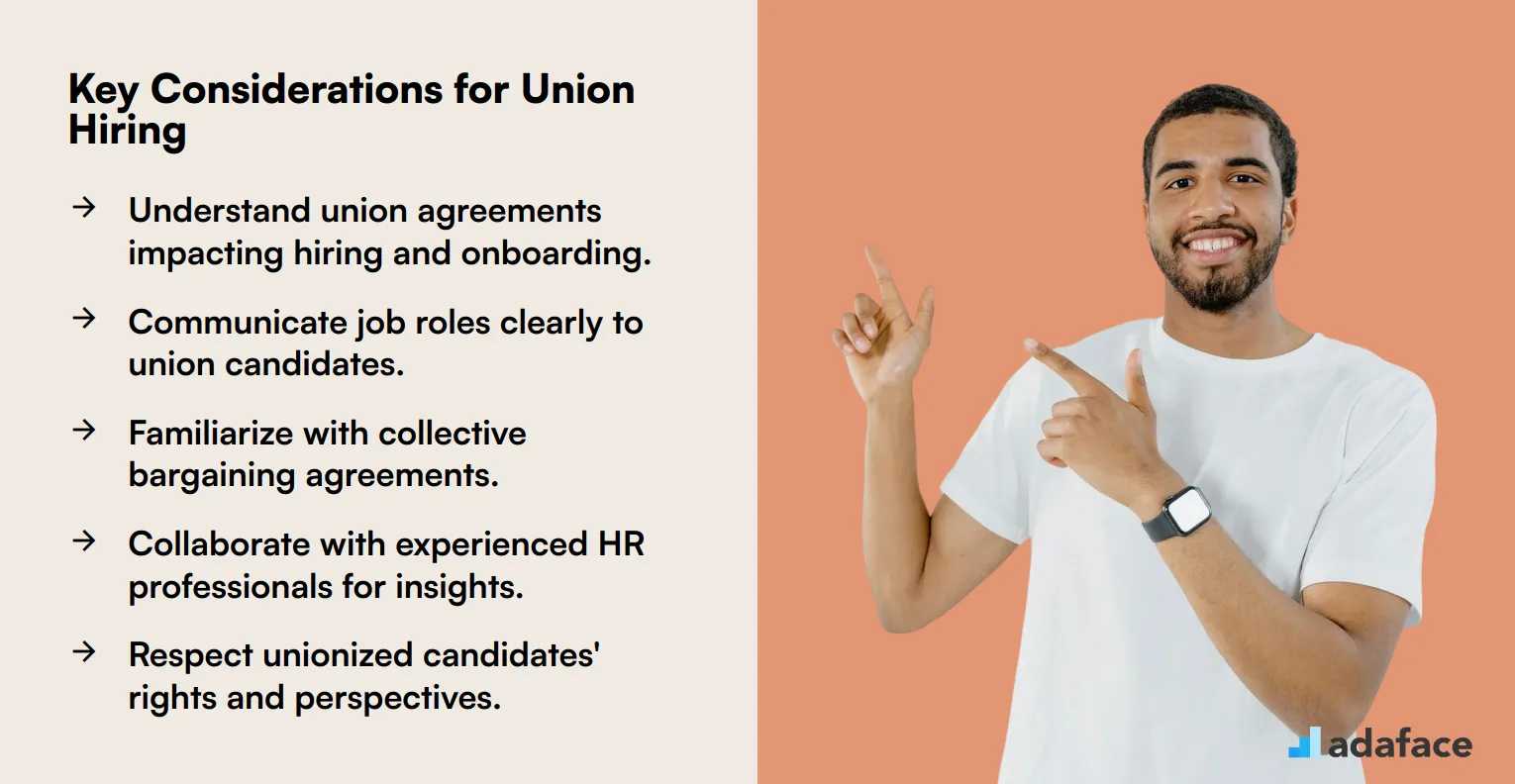Navigating the world of labour unions can be tricky for recruiters. Understanding their role and impact is key to talent acquisition success.
This guide breaks down labour unions, their terminology, and how they affect your hiring strategies. We'll also cover challenges and tips for working with unionized candidates.
Table of contents
What are labour unions and why do they matter?
Labour unions, also known as trade unions, are organized groups of workers who come together to make decisions about the conditions of their work. They play a significant role in negotiating wages, work hours, benefits, workplace safety, and other employment terms with employers.
Unions matter because they provide a collective voice for workers, ensuring fair treatment and protecting their rights. By banding together, workers can negotiate more effectively with employers than they could individually.
For recruiters and hiring managers, understanding labour unions is important as they can impact hiring practices and employment conditions. Unions can influence employment status and dictate terms that affect how new hires are onboarded.
Moreover, unions often provide training and skill development opportunities for their members, which can be beneficial for employers seeking skilled workers. This can be particularly relevant in industries where specific skills and certifications are required.
In essence, labour unions are a key component of the employment landscape, shaping how workers and employers interact. They are integral to maintaining a balanced and fair workplace environment, which is crucial for both employee satisfaction and organizational success.
Common terms used in labour union discussions
In labour union discussions, understanding common terms can significantly aid recruitment and HR professionals. Terms like "collective bargaining" refer to the negotiation process between employers and a group of employees aimed at reaching agreements to regulate working conditions.
"Arbitration" is another term, where a neutral third party is brought in to resolve disputes that cannot be settled through negotiation. This process is often binding, meaning the decision is final and must be adhered to by both parties.
The term "grievance" is used to describe a formal complaint raised by an employee or a union regarding workplace issues. This can include disputes over contract terms, working conditions, or unfair treatment.
"Strike" is a well-known term that describes a work stoppage caused by the mass refusal of employees to work, often used as a protest against terms of employment. Understanding these terms can help in navigating the complexities of unionized environments.
Lastly, "union dues" are fees paid by members to the union to fund its operations, including negotiations and other union activities. These terms are key to comprehending the dynamics of labour unions and their impact on the workplace.
How labour unions impact recruitment and hiring
Labour unions play a significant role in shaping recruitment and hiring practices. They often negotiate terms that can influence job descriptions, compensation packages, and working conditions, impacting how recruiters approach potential candidates.
Unions can affect the types of roles that are in demand, particularly in industries where union presence is strong. This can lead to a focus on hiring for specific skills or qualifications that align with union agreements, influencing the recruitment strategies employed by companies.
The presence of labour unions can also impact the selection process, as companies may need to consider union rules and regulations when screening and hiring candidates. This can add an additional layer of complexity to the recruitment process, requiring recruiters to be well-versed in union guidelines.
Moreover, labour unions can influence the negotiation phase of hiring, as they often set precedents for salary and benefits expectations. Recruiters may need to adjust their offers to align with union standards, which can affect the overall hiring budget and strategy.
Finally, unions can impact employee retention and turnover rates, as they often advocate for better working conditions and job security. This can influence how recruiters position the organization to potential hires, as they may highlight union benefits as part of the employment package.
Key differences between labour unions and trade unions
Labour unions and trade unions are often used interchangeably, but they have distinct roles and scopes. A labour union typically represents workers within a specific company or industry, focusing on negotiating wages, work conditions, and benefits. In contrast, a trade union represents workers from a specific trade or craft, providing a broader scope of advocacy across multiple industries.
Labour unions primarily focus on collective bargaining within a single organization, aiming to improve the immediate work environment for their members. Trade unions, however, engage in broader political and social advocacy, often influencing legislation and policy that affects their members across various sectors.
The membership structure also differs between the two. Labour unions are generally organized by company, with members being employees of a particular organization. Trade unions are organized by trade, with members joining based on their specific skills or craft, regardless of their employer.
Understanding these differences is important for recruitment professionals when navigating employee relations and negotiations. Recognizing whether a candidate is affiliated with a labour or trade union can provide insights into their professional background and expectations. This knowledge can aid in creating more effective recruitment strategies and fostering positive workplace relations.
Challenges faced by HR professionals with unionized workforces
HR professionals managing unionized workforces often encounter unique challenges that require careful navigation. One significant issue is the negotiation of collective bargaining agreements, which can be complex and time-consuming, impacting the overall productivity of the organization.
Another challenge is maintaining open communication channels between management and union representatives. This is crucial to prevent misunderstandings and ensure that both parties are aligned on workplace policies and expectations.
Additionally, HR must be adept at handling grievance procedures, as these can arise more frequently in unionized environments. Effective conflict resolution skills are essential to address these grievances promptly and fairly.
Balancing the needs of the organization with the rights of unionized employees can also be a delicate task. HR professionals must ensure compliance with labor laws while fostering a positive work environment.
Lastly, adapting to changes in labor laws and union regulations is a constant requirement for HR teams. Staying informed and proactive in implementing necessary adjustments is key to minimizing disruptions in the workplace.
Tips for recruiters working with unionized candidates
Recruiters working with unionized candidates need to be aware of unique considerations that may arise during the hiring process. Understanding the employment status of these candidates is important, as union agreements often dictate specific terms and conditions.
Communicating transparently about the role and expectations is crucial when engaging with unionized candidates. This includes clearly outlining job responsibilities and any potential overlaps with union rules or agreements.
Familiarize yourself with the collective bargaining agreements that apply to the candidates you're considering. These agreements can impact various aspects of employment, such as wages, benefits, and working hours.
It's beneficial to collaborate with HR professionals who have experience in union environments. Their insights can help navigate the complexities of union negotiations and ensure compliance with all relevant regulations.
Finally, approach discussions with unionized candidates with respect and openness. Acknowledging their rights and understanding their perspectives can foster a positive hiring experience and lay the groundwork for a successful working relationship.

Conclusion
Understanding labour unions is key for HR professionals and recruiters in today's job market. This knowledge helps navigate complex hiring processes and maintain positive relationships with unionized workforces.
Familiarity with union terms and practices can lead to smoother negotiations and better candidate experiences. By staying informed about union dynamics, recruiters can adapt their strategies and ensure compliance with collective agreements.
Remember, working with unions requires patience, clear communication, and respect for established procedures. Embracing this approach can lead to successful hires and harmonious workplace relationships in unionized environments.
Labour Union FAQs
The primary goal is to advocate for workers' rights and interests. This includes negotiating better wages, benefits, and working conditions with employers.
Unions can influence hiring through collective bargaining agreements. These agreements may specify hiring preferences, procedures, and required qualifications.
Challenges can include navigating complex contracts, dealing with seniority-based systems, and ensuring compliance with union regulations. Understanding these aspects is key to inclusive hiring.
Be transparent about the union's role and the candidate's rights. Understand the collective bargaining agreement and address any concerns the candidate may have.
A closed shop requires employees to be union members before being hired, which is illegal in many places. An open shop allows employees to choose whether or not to join the union.
Open communication, mutual respect, and a willingness to collaborate are essential. Addressing concerns proactively and finding common ground can build trust.

40 min skill tests.
No trick questions.
Accurate shortlisting.
We make it easy for you to find the best candidates in your pipeline with a 40 min skills test.
Try for freeRelated terms



